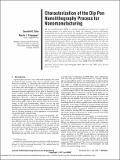Characterization of the Dip Pen Nanolithography Process for Nanomanufacturing
Author(s)
Saha, Sourabh Kumar; Culpepper, Martin
Download041005_1.pdf (1.542Mb)
PUBLISHER_POLICY
Publisher Policy
Article is made available in accordance with the publisher's policy and may be subject to US copyright law. Please refer to the publisher's site for terms of use.
Terms of use
Metadata
Show full item recordAbstract
Dip pen nanolithography (DPN) is a flexible nanofabrication process for creating 2-D nanoscale features on a surface using an “inked” tip. Although a variety of ink-surface combinations can be used for creating 2-D nanofeatures using DPN, the process has not yet been characterized for high throughput and high quality manufacturing. Therefore, at present it is not possible to (i) predict whether fabricating a part is feasible within the constraints of the desired rate and quality and (ii) select/design equipment appropriate for the desired manufacturing goals. Herein, we have quantified the processing rate, tool life, and feature quality for DPN line writing by linking these manufacturing metrics to the process/system parameters. Based on this characterization, we found that (i) due to theoretical and practical constraints of current technology, the processing rate cannot be increased beyond about 20 times the typical rate of ∼1 μm2 /min, (ii) tool life for accurate line writing is limited to 1–5 min, and (iii) sensitivity of line width to process parameters decreases with an increase in the writing speed. Thus, we conclude that for a high throughput and high quality system, we need (i) parallelization or process modification to improve throughput and (ii) accurate fixtures for rapid tool change. We also conclude that process control at high speed writing is less stringent than at low speed writing, thereby suggesting that DPN has a niche in high speed writing of narrow lines.
Date issued
2011-07Department
Massachusetts Institute of Technology. Department of Mechanical Engineering; Massachusetts Institute of Technology. Laboratory for Manufacturing and ProductivityJournal
Journal of Manufacturing Science and Engineering
Publisher
ASME International
Citation
Saha, Sourabh K., and Martin L. Culpepper. “Characterization of the Dip Pen Nanolithography Process for Nanomanufacturing.” Journal of Manufacturing Science and Engineering 133, no. 4 (2011): 041005. © 2011 by ASME
Version: Final published version
ISSN
10871357